-
Answer these questions.
-
What is “semaseology”?
-
Why is the term “semantics”
ambiguous? -
Why is meaning one of the
most controversial terms in linguistics? -
How does Prof. Smirnitsky
define meaning? -
What are the main approaches
to the study of meaning? What are their advantages and
disadvantages? -
What is “the semiotic
triangle”? What does it show?
-
What does the diagram below
prove? Explain your answer.
M
G
C
F
F
BOSS
HE
-
True or false? Correct the
wrong statements.
-
Meaning is the component of
the word through which a concept is communicated. -
Meanings are subjective as
they exist in the minds of individuals. -
Meaning enables the word to
name real-world objects. -
Meaning is an inherent
property of the word and thus it is a linguistic category. -
Meaning is a certain kind of
information or knowledge of real-world objects and phenomena. -
Meaning enables words to be
used in communication. -
Word meaning is closely
connected but not identical with either the sound-form or the
referent.
-
Could you define these terms?
denotation, connotation,
emotive charge, evaluation, stylistic reference, emotive
implications.
-
Identify the components of
the meaning of the following words. In which word is the content
primarily evaluative or primarily referential?
dog, fascist, typewriter;
wife-spouse-consort; child-brat-urchin;
stubborn-mulish;
horse-steed
-
There are a lot of words
whose content is largely emotive. Emotion or evaluation can be a
major part of the word’s meaning, if not the whole of it,
e.g.
marvellous,
monstrous, glorious.
Could you give 3 more examples
of “emotive language”?
Use the words in context,
e.g. You
look fabulous! Horrendous prices!
Why are such words called
“loaded language”?
-
Can you match the colours
with their connotations in English? Are any of these the same in
Russian?
1. blue purity
2. green evil
3. yellow miserable
4. red inexperienced
5. white danger
6. black cowardly
-
What
personal association do the words
below have for you? What are their connotations for English speakers
in general?
shark, scar, diamond.
-
What is the stylistic
reference of the words in italics?
-
Subsequently,
three people were arrested. -
Give me
that thingy
there, yea, that bottle opener. -
I saw him
conversing
with a woman in a red car.
How can you make these
sentences more formal/informal?
-
Do you agree with the following statement? Why or why not?
«The relationship between
the form of the word and its meaning is conventional and arbitrary».
-
Are these words motivated? If
they are, state the type of motivation and its degree,
ding-dong,
dragonfly, handbag, to spam, gooseberry, rat-a-tat-tat,
antiglobalism, spanner, flame “an
angry email”,
bluebottle, porter, jungle “a
garden or other places with a lot of plants which are not under
control”,
phonaethesia.
-
Find the odd-one-out. Explain
your decision.
-
butterfly, buttercup,
butterknife, butter-fingers; -
buzz, swish, crunch,
splash, bang, slide; -
wrapper, feeder, ginger,
sleeper, printer; -
a sweet smile, a sweet
face, a sweet apple, a sweet voice.
Соседние файлы в предмете [НЕСОРТИРОВАННОЕ]
- #
- #
- #
- #
- #
- #
- #
- #
- #
- #
- #
Слайд 1Semantics
Semantics (semasiology) is a branch of lexicology that is devoted to
the study of word meaning.
the semantics of a word = the meaning of a word
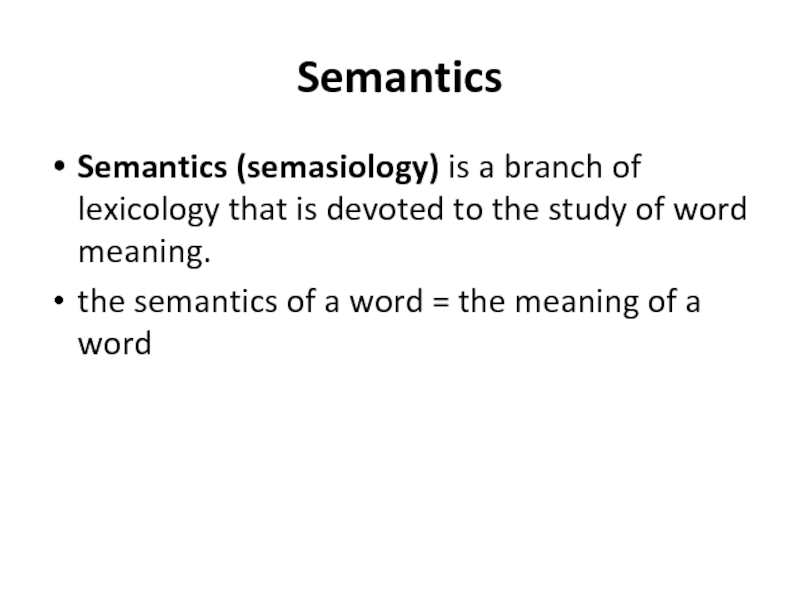
Слайд 2Meaning
a component of the word through which a concept is communicated,
thus enabling this word to denote real objects, qualities and abstract notions.
Two aspects of the word:
the outer aspect, the material side of the word (план выражения) (i.e. its sound form)
the inner aspect, the ideal side of the word (план содержания) (its meaning).
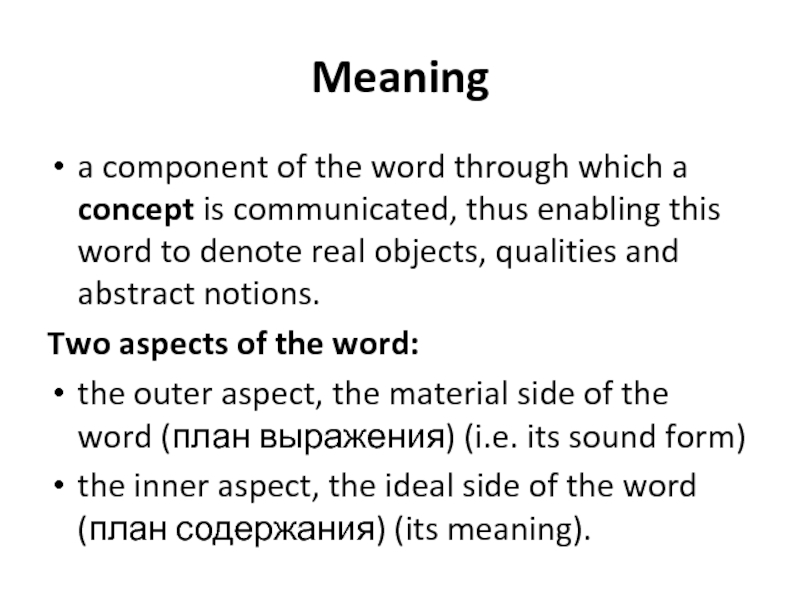
Слайд 3Types of meaning
Grammatical meaning: tables, students, houses, jokes — the grammatical
meaning of plurality.
The component of meaning recurrent in identical sets of individual forms of different words. E.g. the tense meaning (went, answered, wrote), the case meaning (parents’, sister’s, student’s, etc.).
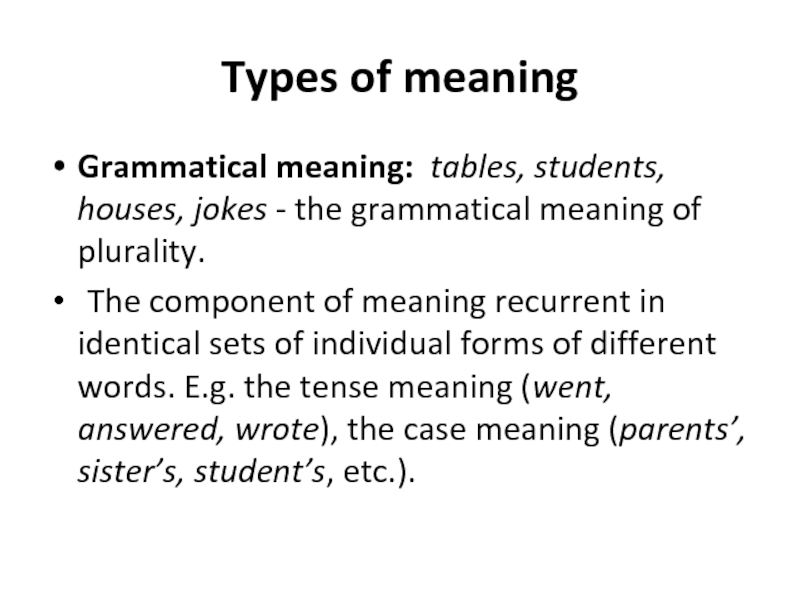
Слайд 4Types of meaning
Lexical meaning is identical in all the forms of
the word. E.g. write, writes, wrote, writing, written.
The meaning proper to the given linguistic unit in all its forms and distributions
Both the lexical and grammatical meanings make up the word-meaning as neither can exist without the other.
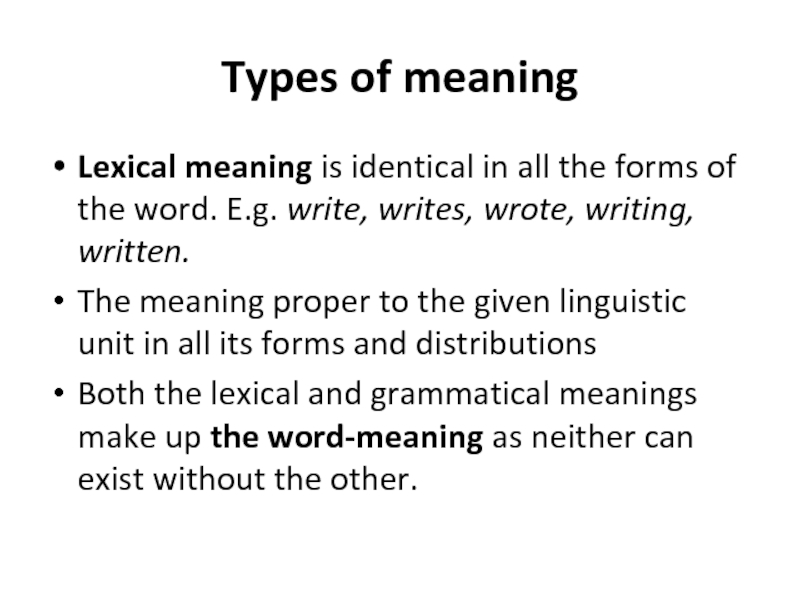
Слайд 5The components of meaning
the denotative component (denotation)
the connotative component (connotation)
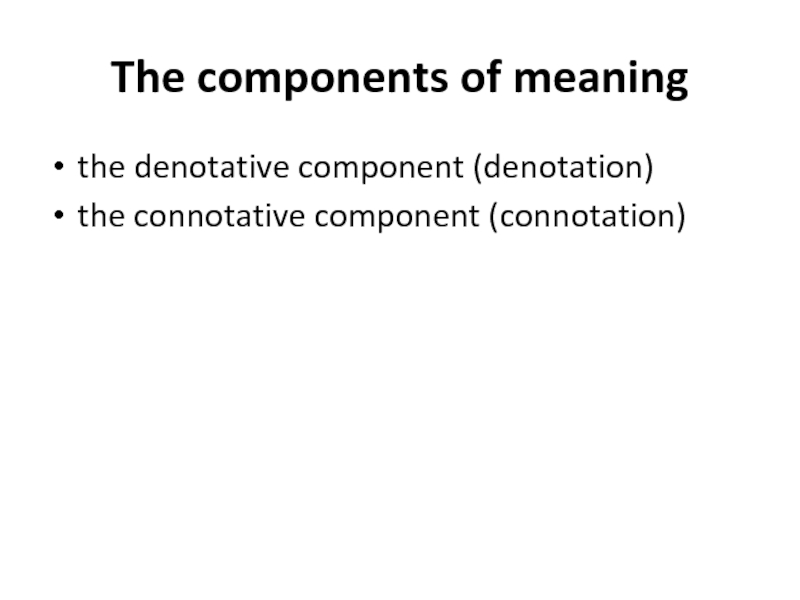
Слайд 6The denotative component of meaning (denotation)
is the principal part of meaning
that makes communication possible. It expresses the conceptual content of a word.
lonely: alone, without a company
notorious: well known
celebrated: well known
to adore: to love
to glare: to look
to glance: to look
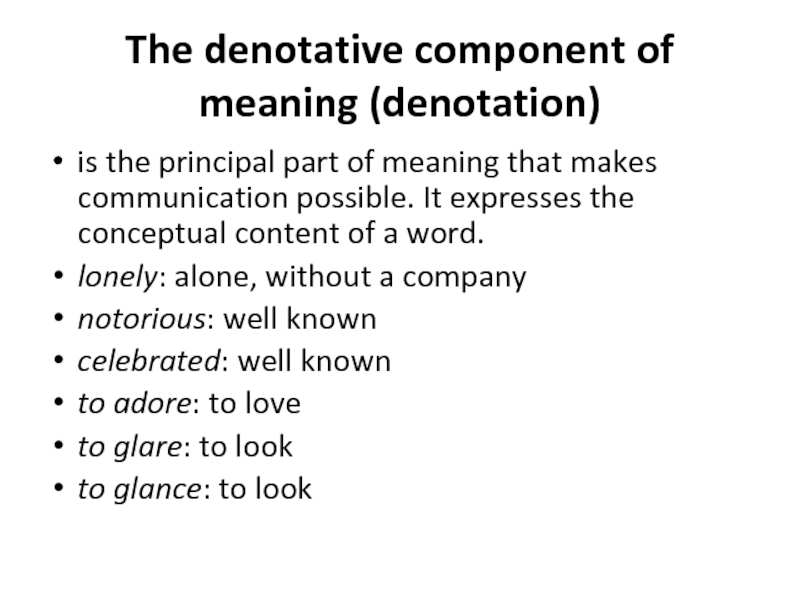
Слайд 7The connotative component of meaning (connotation)
is what the word implies in
addition to its denotative meaning. It is the set of associations that a word’s use can evoke.
E.g. a hovel: “a small house” + “miserable, dirty, in bad repair, unpleasant to live in”.
Types of connotation:
emotive
evaluative
expressive (intensifying)
pragmatic (i.e. connotation of duration, manner, cause, etc.)
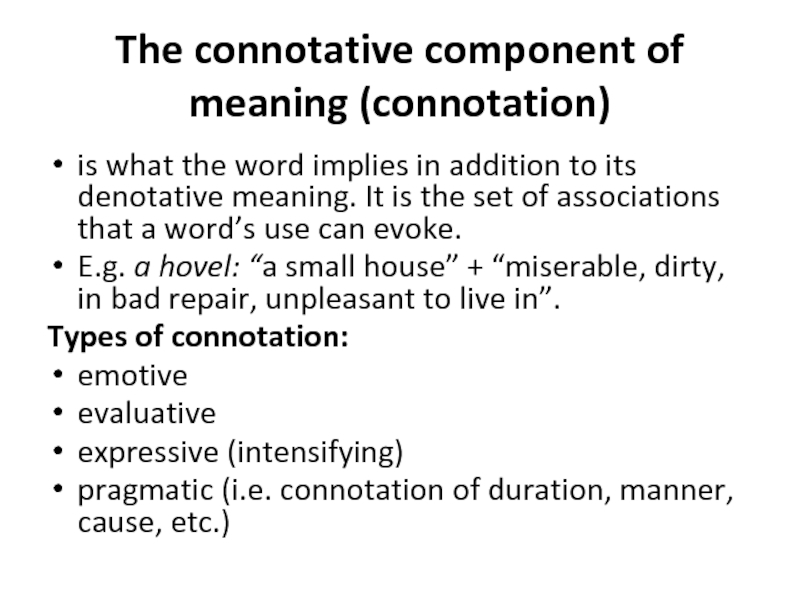
Слайд 8The connotative component
lonely: unhappy (emotive connotation)
notorious: about something bad (evaluative connotation,
negative)
celebrated: about something good (evaluative connotation, positive)
to adore: deep feeling (expressive connotation)
to glare: steadily (connotation of duration) + in angry, fierce way (emotive connotation)
to glance: briefly (connotation of duration)
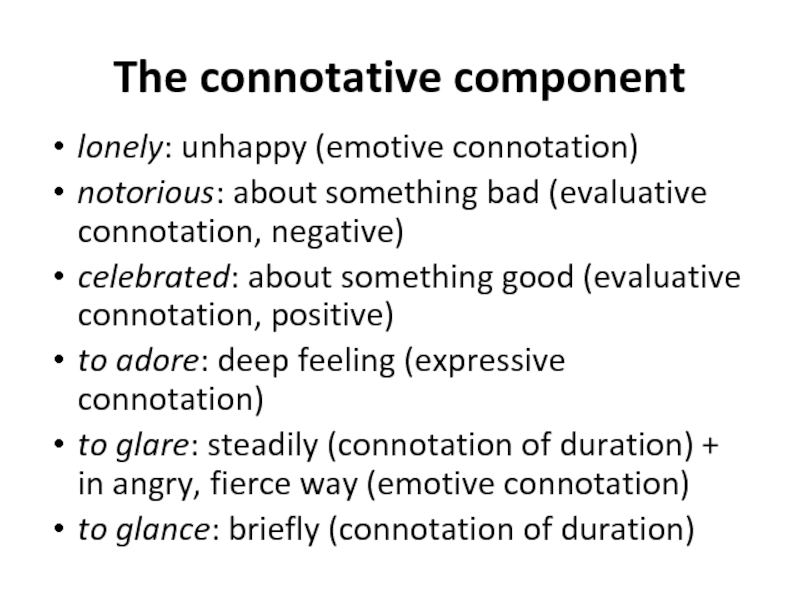
Слайд 9Denotative and connotative components
Often a word’s connotation is fully explained in
the dictionary.
Otherwise it can be realized through the context.
E.g. Los Angeles is notorious for its smog.
Denotative and connotative components make up the semantic structure of a word.
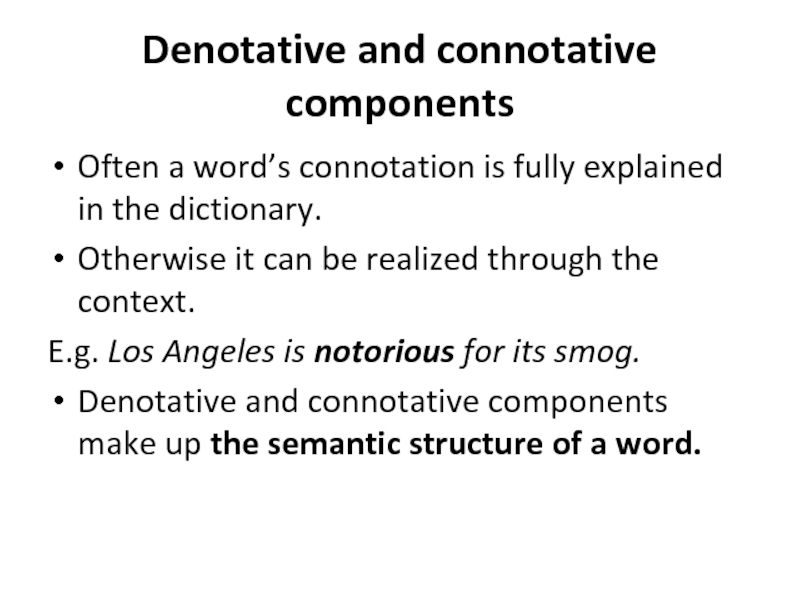
Слайд 10Semantic Transfer
The process of development of a new meaning (or a
change of meaning) is termed transference.
Types of transference:
metaphor
metonymy
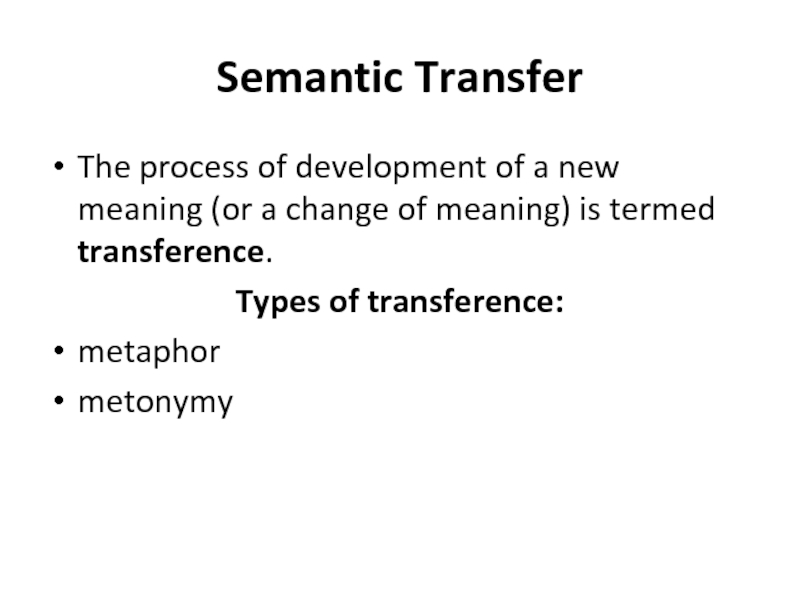
Слайд 11Metaphor
Metaphor is a type of transference based on the similarity of
the objects, qualities or phenomena denoted by the words.
Types of metaphor:
similarity of shape: thus we can speak of the eye of a needle
position: head of a tree
function: hands of a clock, etc.
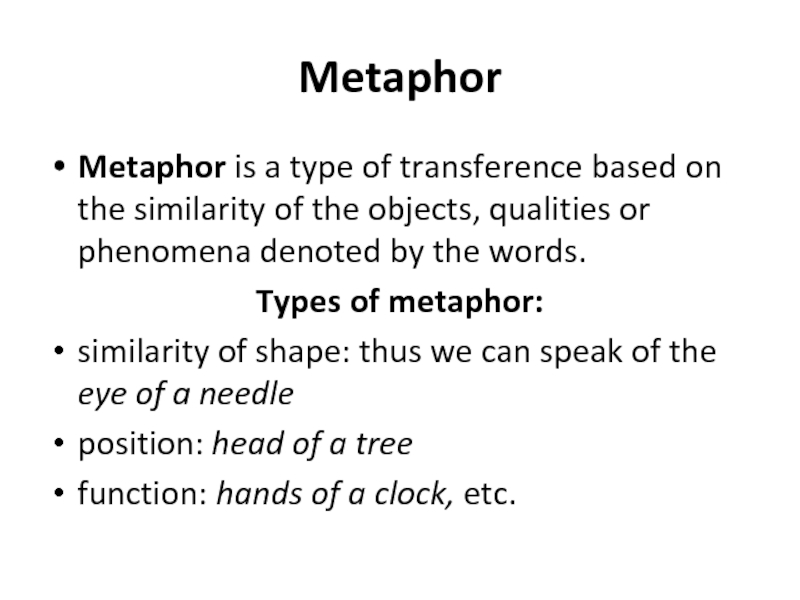
Слайд 12Metonymy
is based on the contiguity (смежность) of the objects, qualities or
phenomena denoted by the words.
Types of metonymy:
The name of the place — its inhabitants: school
Quality — the subject of this quality: beauty Material — the product made of this material: bronze, clay, silver
Animal – the meat of this animal: fowl, turkey Action – the subject of the action: safeguard, support
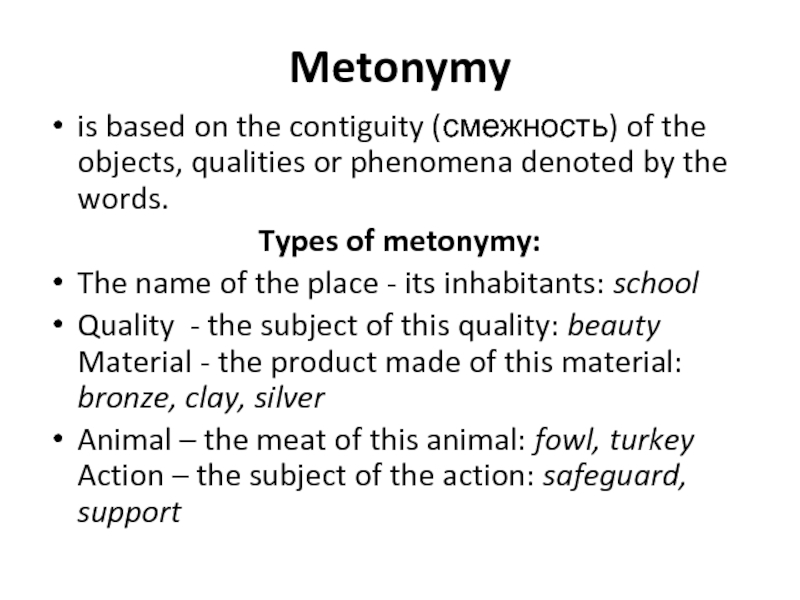
Слайд 13
Results of semantic change
Change of the denotative component:
broadening (generalization) of meaning:
bird, pipe
narrowing (specialization) of meaning: hound, girl
Change of the connotative component:
Elevation of meaning (the improvement of the connotative component of meaning): minister, knight
Degeneration of meaning (the acquisition by the word of some derogatory emotive charge): boor, silly
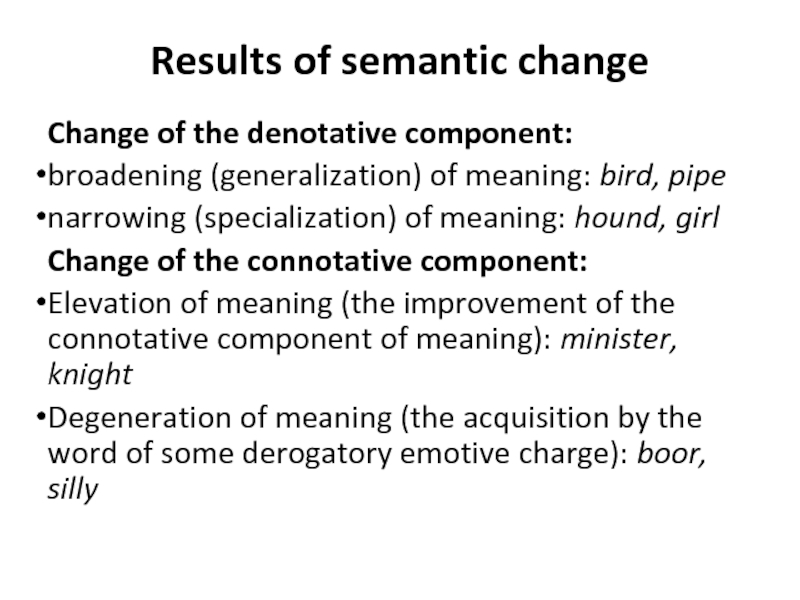
Слайд 14
Polysemy
Polysemy is the ability of a word to possess several meanings.
E.g. bright: ‘shining’; ‘intelligent’.
A word having several meanings is called polysemantic.
Words having only one meaning are called monosemantic (morpheme, antibiotics).
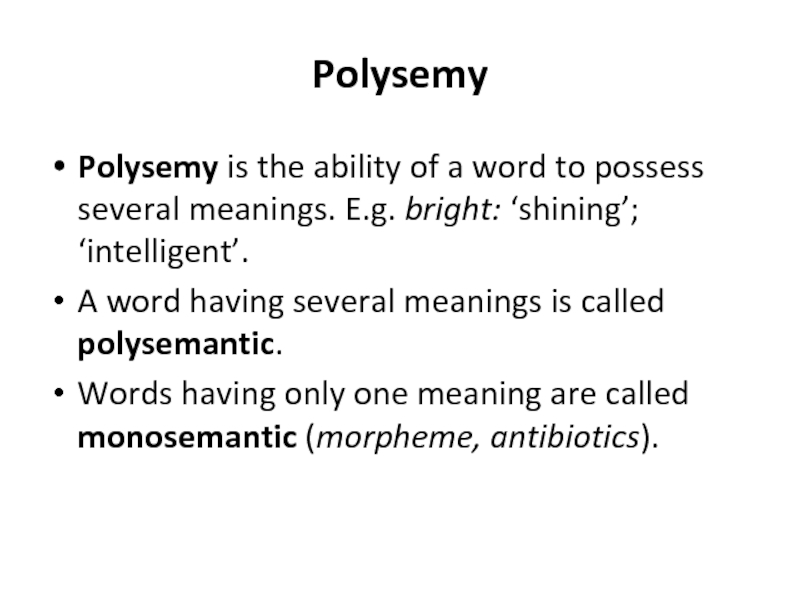
Слайд 15Lexico-semantic variant (A. I. Smirnitsky)
LSV is a two-sided unit, the material side
of which is the sound-form of a word, while the ideal side is one of the meanings of the given word.
The semantic centre of the word is the part of meaning which remains constant in all the lexico-semantic variants of the word.
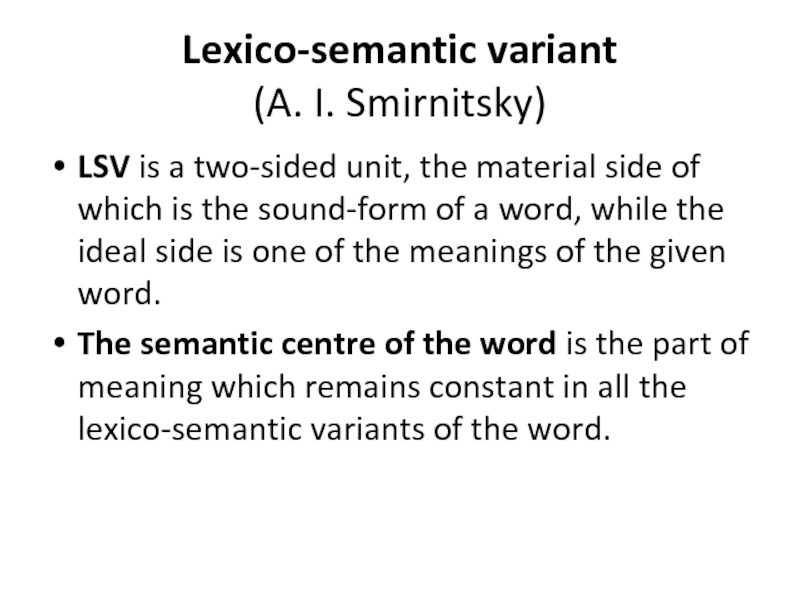
Слайд 16The semantic centre of the word
E.g. dull:
Boring – the deficiency in
interest
Stupid — the deficiency in intellect
Not clear or bright — the deficiency in colour
Not loud or distinct — the deficiency in sound
Not sharp — the deficiency in sharpness
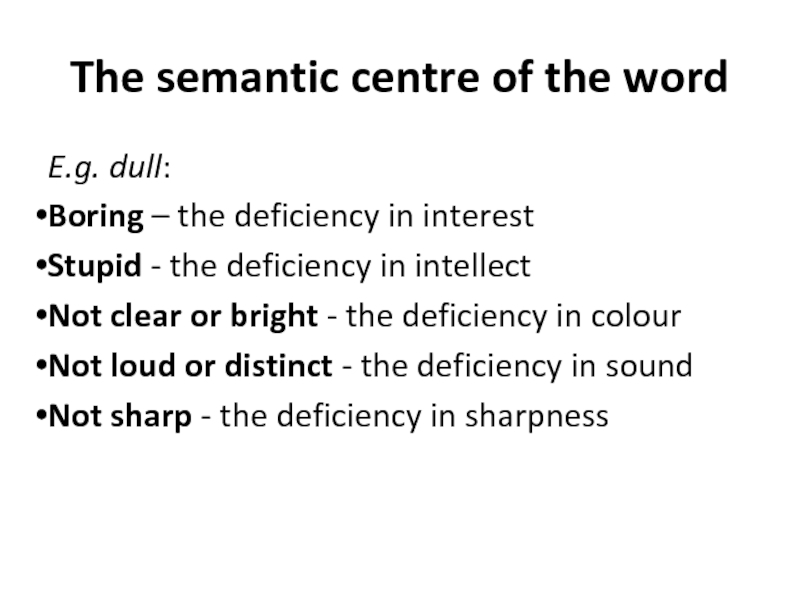
Слайд 17Diachronic perspective of polysemy
If polysemy is viewed diachronically it is understood
as the development of the semantic structure of the word.
Types of meaning:
the primary meaning
the secondary meaning
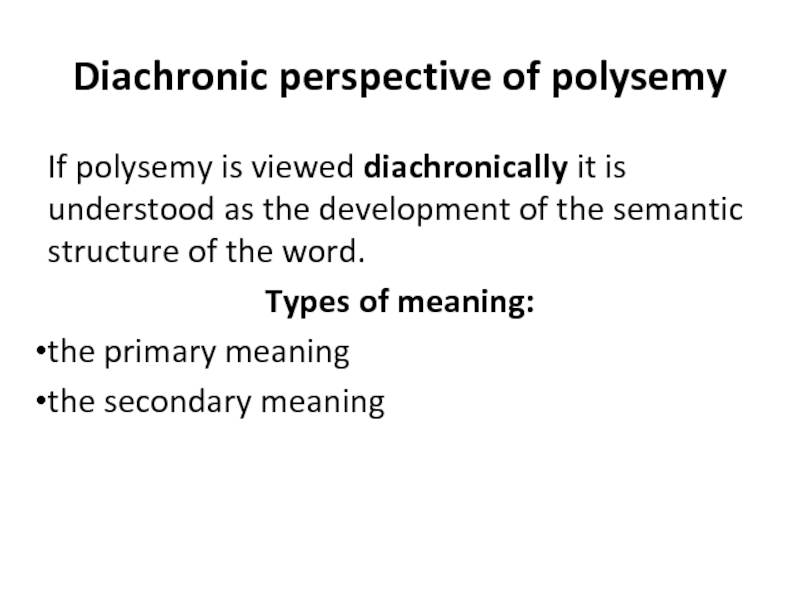
Слайд 18The primary meaning
e.g. table:
a piece of furniture;
people seating at
a table;
a meal;
a list of figures arranged in an ordered way (таблица);
a flat slab of stone or wood (плита)
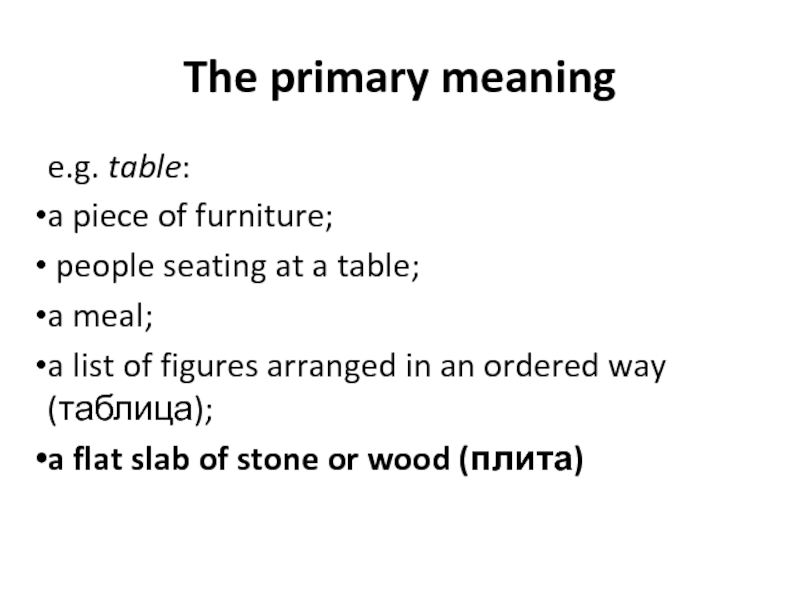
Слайд 19The synchronic perspective of polysemy
Synchronically polysemy is understood as the coexistence
of various meanings of the same word at a certain historical period of the development of the English language.
Types of meaning:
the central (basic) meaning
marginal (minor) meanings
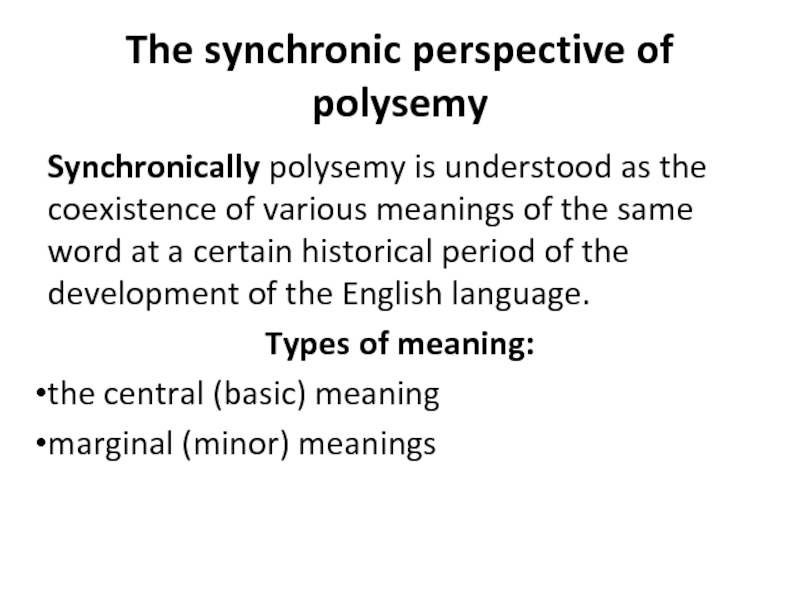
Слайд 20
The central (basic) meaning
The central meaning occurs in different contexts, possesses
the highest frequency of value, while marginal meanings are observed only in certain contexts and are less frequent.
E.g. table:
a piece of furniture;
people seating at a table;
a meal;
a list of figures arranged in an ordered way;
a flat slab of stone or wood
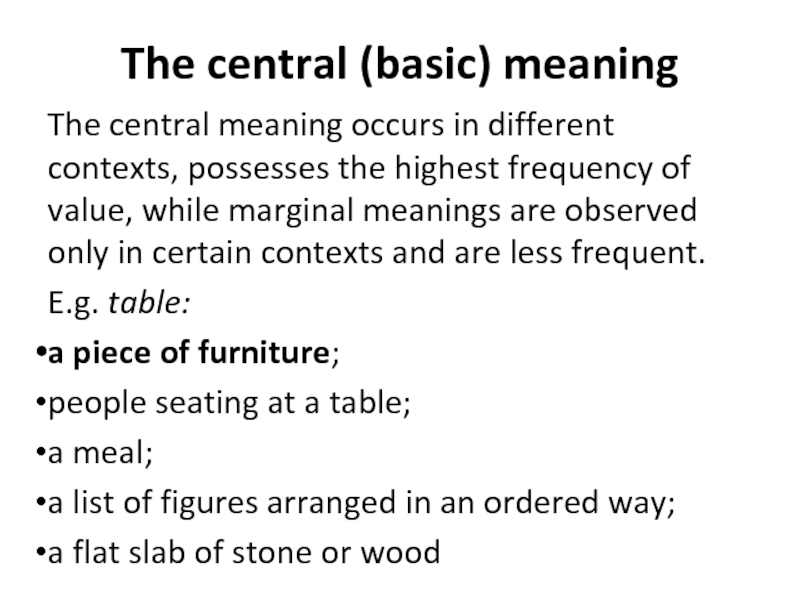
Слайд 21
Meaning and context
The actual meaning of a polysemantic word is revealed
through the context.
Context is the minimal stretch of speech determining each individual meaning of the word
Types of context:
linguistic
extra-linguistic
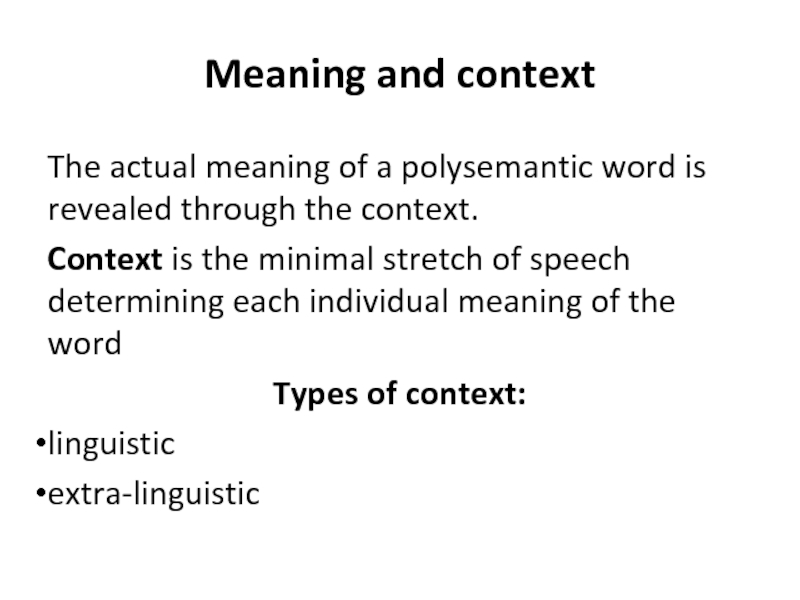
Слайд 22Linguistic contexts
lexical: the groups of lexical items are combined with
the polysemantic word under consideration.
E.g. heavy: ‘of great weight’ (heavy load, table); ‘abundant, striking, falling with force’ (heavy rain, storm, snow, wind); ‘the larger kind of smth’ (heavy industry, artillery, arms )
grammatical: the grammatical (syntactic) structure of the context serves to determine various individual meanings of a polysemantic word.
E.g. to make ‘to force, to induce’: to make + prn. + verb (to make smb. laugh, work, sit); ‘to become’: to make + adj. + noun (to make a good wife, a good teacher)
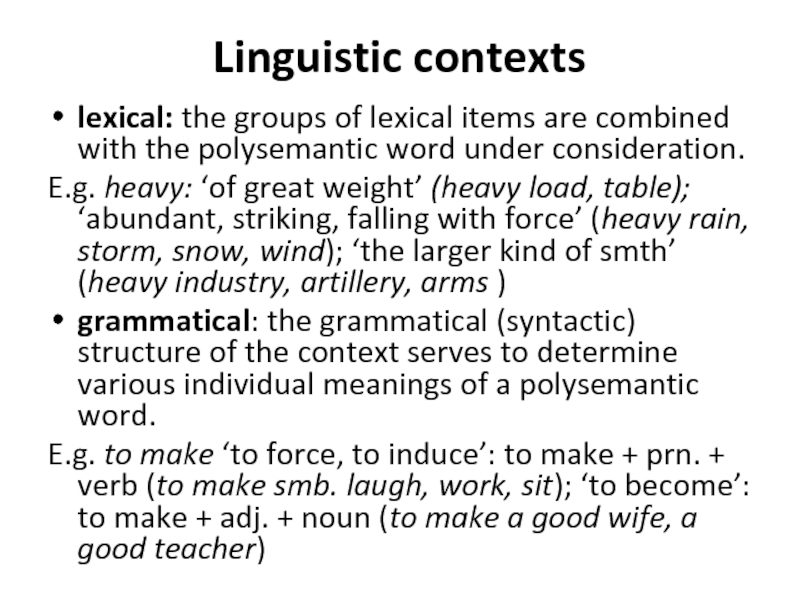
Слайд 23Extra-linguistic context
The meaning of a word is ultimately determined by the
actual speech situation in which the word is used.
E.g. The bill is large. (the meaning is ambiguous)
The bill is large but need not be paid. (the meaning is clear)
E.g. John was looking for the glasses. (the meaning is ambiguous)
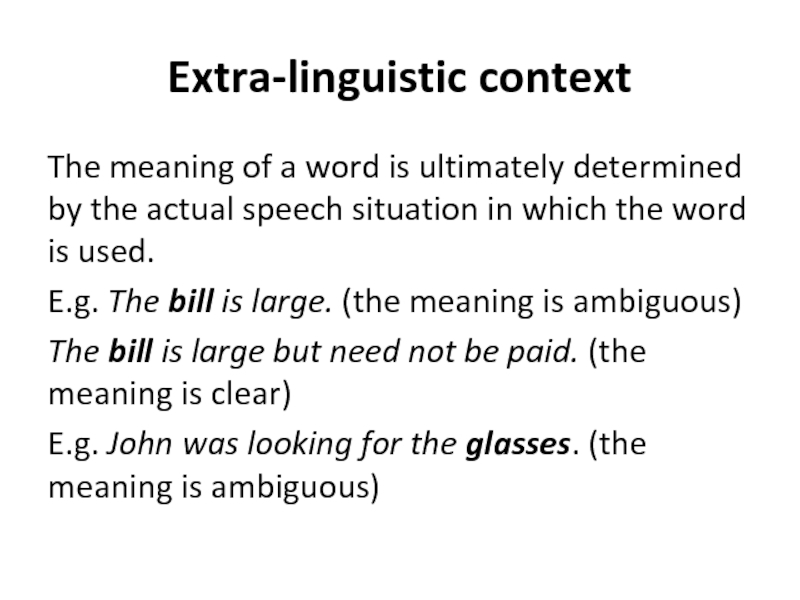
LECTURE 7 SEMASIOLOGY. MEANING.
1. 1. 2. 1. 3. 2. 3. 4. Meaning as a Linguistic Notion Referential and Analytical Definitions of Meaning Functional or Contextual Definitions of Meaning Operational or Information-Oriented Definition of Meaning Two Approaches to the Content Facet of Linguistic Units. Naming. Types of Meaning. Aspects of Lexical Meaning
L. BLOOMFIELD (1933): In order to give a scientifically accurate definition of meaning for every form of a language, we should have to have a scientifically accurate knowledge of everything in the speaker’s world. The actual extent of human knowledge is very small, compared to this. We can define the meaning of a speech-form accurately when this meaning has to do with some matter of which we possess scientific knowledge. . . but we have no precise way of defining words like love or hate which concern situations that have not been accurately classified.
TWO PERSPECTIVES OF SEMANTICS The area of study dealing with meaning is called semantics. Philosophical semantics is concerned with the logical properties of language, the nature of formal theories, and the language of logic. Linguistic semantics involves all aspects of meaning in natural languages, from the meaning of complex utterances in specific contexts to that of individual sounds in syllables.
Pragmatic semantics studies the meaning of utterances in context. Sentence semantics handles the meaning of sentences as well as meaning relations between sentences. Lexical semantics deals with the meaning of words and the meaning relations that are internal to the vocabulary of the language.
Semantics covers all aspects of human language, it must be considered not only as a division of lexicology, but also as part of phonology, syntax, discourse analysis, textlinguistics, pragmatics, etc.
SEMASIOLOGY The branch of lexicology that is devoted to the study of meaning is called semasiology. Semasiology departs from a word or lexical expression and asks for its meaning, in different senses; this discipline within linguistics is concerned with the question “What does X-word mean? ”
MEANING AND WORD SENSE Meaning is a component of the word through which the concept is communicated. Word sense may be regarded as a purely mental object; or as a structure of some kind of primitive units of meaning; or as the set of all the things in the world that the sense may denote; or as a prototype that other objects resemble to a greater or lesser degree; or as an intension or description or identification.
MEANING AS A LINGUISTIC NOTION There are three main categories of definitions of meaning which may be referred to as referential or analytical definitions of meaning; functional or contextual definitions of meaning; operational or information-oriented definitions of meaning.
REFERENTIAL OR ANALYTICAL DEFINITIONS OF MEANING Three components closely connected with meaning: 1. the sound-form of the linguistic sign; 2. the concept underlying this sound-form; 3. the referent, i. e. the part or aspect of reality to which the linguistic sign refers.
BASIC TRIANGLE Concept Sound-form Referent
The sound-form of the word is not identical with its meaning. Concept is a category of human cognition. Concept is the thought of an object that singles out its essential features. Concepts are the results of abstraction and generalization. The concepts expressed by one and the same word in one language can be expressed by two different words in the other language. Distinguishing meaning from the referent, i. e. from the thing denoted by the linguistic sign, is of the utmost importance. *Meaning is not to be identical with any of the three points of the triangle — the sound-form, the concept and the referent, but is closely connected with them.
FUNCTIONAL OR CONTEXTUAL DEFINITIONS OF MEANING The meaning of a linguistic unit can be studied only through its relation to other linguistic units. to move (to move a chair; we move) movement (movement of a car; slow movement) The position of a word in relation to other words is called distribution of the word.
to take (to take a seat; to take to smb. ) Context is the minimum stretch of speech necessary and sufficient to determine which of the possible meanings of a polysemantic word is used.
OPERATIONAL OR INFORMATION-ORIENTED DEFINITIONS OF MEANING Information conveyed from the speaker to the listener in the process of communication. John came at 6 o’clock. The direct information conveyed by the units constituting the sentence may be referred to as meaning while the information added to the extralinguistic situation may be called sense.
TWO APPROACHES TO THE CONTENT FACET OF LINGUISTIC UNITS The study of the semantic side of the word may start with the name or with the object denoted. In the first case the study will consist in considering different meanings of the word, determining interrelations between them, as well as discovering semantic relations between different words. Such approach is called semasiological. The second approach is the reverse of the first: it starts from an object and consists in analyzing different words correlated with it. This approach is called onomasiological (from the Greek onoma = ‘name’). The onomasiological approach helps to discover how meaning is formed, considering its basic properties and peculiarities.
The semasiological approach name object The onomasiological approach
NAMING the nominator and the referent 1. The process of nomination starts with forming a concept of the object. There are several factors which influence the formation of concepts: 1) the objective reality itself; 2) the level of knowledge about the nature and structure of the given object; 3) the general system of notions typical of the given language community, e. g. philosophic, moral, religious and other principles existing at the given period of time.
2. The next stage in the process of naming is the designation of class of objects under nomination with the help of linguistic means. The features chosen as the basic characteristics of the object form the denotatum. It is really what the word denotes, while the concept and the referent are what the word is correlated with. The interrelations of concept and denotatum may be different, in some cases the denotatum is close to the concept, in other cases it is much narrower than the underlying concept (see next slide).
The referent (e. g. a concrete animal) concept the denotatum of the word cat (‘small fury domestic animal often kept as a pet. to catch mice, etc. ‘) the denotatum of the word mouser (i. e. not any cat, but ‘a cat that catches mice’)
NAMING 3. Information suggested in addition to the denotatum may refer to the positive or negative attitude of the nominator, or it may indicate a certain situation of communication and point out at the participants and their roles. This additional information shapes the communicative value of lexical meaning. 4. The semantic side formed in the process of nomination is to be correlated with certain material structure, i. e. the sound form and the graphic form. The acquisition of the sound and graphic forms makes it possible for the word to be conveyed from one person to another to serve the purposes of communication.
TYPES OF MEANING The grammatical meaning is defined as an expression in speech of relationship between words. Grammatical meaning is the component of meaning recurrent in identical sets of individual forms of different words. The lexical meaning of the word is the meaning proper to the given linguistic unit in all its forms and distributions. The essence of the part-of-speech meaning of a word is revealed in the classification of lexical items into major wordclasses (nouns, verbs, adjectives and adverbs) and minor word-classes (articles, prepositions, conjunctions, etc).
ASPECTS OF LEXICAL MEANING In the general framework of lexical meaning several aspects can be singled out: 1. 2. 3. the denotational aspect; the connotational aspect; the pragmatic aspect.
The denotational aspect of lexical meaning is the part of lexical meaning which establishes correlation between the name and the object, phenomenon, process or characteristic feature of concrete reality (or thought as such), which is denoted by the given word. It is through the denotational aspect of meaning that the bulk of information is conveyed in the process of communication. The denotational aspect of lexical meaning expresses the notional content of a word.
The connotational aspect of lexical meaning is the part of meaning which reflects the attitude of the speaker towards what he speaks about. Connotation conveys additional information in the process of communication. Connotation includes: 1. the emotive charge, e. g. daddy — father, 2. evaluation, which may be positive or negative, e. g. clique – group; 3. intensity (or expressiveness), e. g. adore — love; 4. imagery, e. g. to wade through the book
The pragmatic aspect of lexical meaning is the part of meaning, that conveys information on the situation of communication. 1) 2) information on the «time and space» relationship of the participants (come – go); information on the participants and the given language community: (1) They chucked a stone at the cops, and then did a bunk with the loot. (2) After casting a stone at the police, they absconded with the money. 3) 4) information on the tenor of discourse; information on the register of communication (the general type of the situation of communication grading the situations in formality (variations ranging from extreme degrees of formality through norm to extreme non-formality)).
ASPECT OF LEXICAL MEANING Denotational LEXICAL MEANING Connotational Emotive charge Expressiveness Pragmatic Evaluation Imagery Time and space Participants and language community Tenor of discourse Register of communication
Слайды и текст этой презентации
Слайд 1
Слайд 2
Описание слайда:
Plan:
Semantics / semasiology. Different approaches to word-meaning.
Types of word-meaning.
Polysemy. Semantic structure of words. Meaning and context.
Change of word-meaning: the causes, nature and results.
Слайд 3
Описание слайда:
List of Terms:
semantics
referent
referential meaning
grammatical meaning
lexical meaning
denotational meaning
connotational meaning
polysemantic word
polysemy
lexical-semantic variants
basic meaning
peripheral meaning
primary meaning
secondary meaning
Слайд 4
Описание слайда:
It is meaning that makes language useful.
George A. Miller,
The science of word, 1991
Слайд 5
Описание слайда:
1. Semantics / semasiology. Different approaches to word-meaning
Слайд 6
Описание слайда:
The function of the word as a unit of communication is possible by its possessing a meaning.
Among the word’s various characteristics meaning is the most important.
Слайд 7
Описание слайда:
«The Meaning of Meaning» (1923) by C.K. Ogden and I.A. Richards – about 20 definitions of meaning
Слайд 8
Слайд 9
Описание слайда:
This linguistic study was pointed out in 1897 by M. Breal
Слайд 10
Описание слайда:
Semasiology is a synonym for ‘semantics’
(from Gk. semasia ‘meaning’ + logos ‘learning’)
Слайд 11
Описание слайда:
Different Approaches to Word Meaning:
ideational (or conceptual)
referential
functional
Слайд 12
Описание слайда:
The ideational theory can be considered the earliest theory of meaning.
It states that meaning originates in the mind in the form of ideas, and words are just symbols of them.
Слайд 13
Описание слайда:
A difficulty:
not clear why communication and understanding are possible if linguistic expressions stand for individual personal ideas.
Слайд 14
Описание слайда:
Meaning:
a concept with specific structure.
Слайд 15
Описание слайда:
Do people speaking different languages have different conceptual systems?
If people speaking different languages have the same conceptual systems why are identical concepts expressed by correlative words having different lexical meanings?
Слайд 16
Описание слайда:
finger ‘one of 10 movable parts of joints at the end of each human hand, or one of 8 such parts as opposed to the thumbs‘
and
палец ‘подвижная конечная часть кисти руки, стопы ноги или лапы животного’
Слайд 17
Описание слайда:
Referential theory is based on interdependence of things, their concepts and names.
Слайд 18
Описание слайда:
The complex relationships between referent (object denoted by the word), concept and word are traditionally represented by the following triangle:
Thought = concept
Symbol = word Referent = object
Слайд 19
Описание слайда:
an animal, with 4
legs and a tail, can bark and bite
dog
Слайд 20
Описание слайда:
Meaning concept
different words having different meanings may be used to express the same concept
Слайд 21
Описание слайда:
Concept of dying
die
pass away
kick the bucket
join the majority, etc
Слайд 22
Описание слайда:
Meaning symbol
In different languages:
a word with the same meaning have different sound forms (dog, собака)
words with the same sound forms have different meaning (лук, look)
Слайд 23
Описание слайда:
Meaning referent
to denote one and the same object we can give it different names
Слайд 24
Описание слайда:
A horse
in various contexts:
horse,
animal,
creature,
it, etc.
Слайд 25
Описание слайда:
Word meaning:
the interrelation of all three components of the semantic triangle: symbol, concept and referent, though meaning is not equivalent to any of them.
Слайд 26
Описание слайда:
Functionalists study word meaning by analysis of the way the word is used in certain contexts.
Слайд 27
Описание слайда:
The meaning of a word is its use in language.
Слайд 28
Описание слайда:
cloud and cloudy
have different meanings because in speech they function differently and occupy different positions in relation to other words.
Слайд 29
Описание слайда:
Meaning:
a component of the word through which a concept is communicated
Слайд 30
Описание слайда:
2. Types of word-meaning
Слайд 31
Описание слайда:
According to the conception of word meaning as a specific structure:
functional meaning: part of speech meaning (nouns usually denote «thingness», adjectives – qualities and states)
grammatical: found in identical sets of individual forms of different words (she goes/works/reads, etc.)
lexical: the component of meaning proper to the word as a linguistic unit highly individual and recurs in all the forms of a word (the meaning of the verb to work ‘to engage in physical or mental activity’ that is expressed in all its forms: works, work, worked, working, will work)
Слайд 32
Описание слайда:
Lexical Meaning:
denotational
connotational
Слайд 33
Описание слайда:
Denotational lexical meaning provides correct reference of a word to an individual object or a concept.
It makes communication possible and is explicitly revealed in the dictionary definition (chair ‘a seat for one person typically having four legs and a back’).
Слайд 34
Описание слайда:
to glare – to look
Слайд 35
Описание слайда:
Connotational lexical meaning is an emotional colouring of the word. Unlike denotational meaning, connotations are optional.
Слайд 36
Описание слайда:
Connotations:
Emotive charge may be inherent in word meaning (like in attractive, repulsive) or may be created by prefixes and suffixes (like in piggy, useful, useless).
It’s always objective because it doesn’t depend on a person’s perception.
Слайд 37
Описание слайда:
2. Stylistic reference refers the word to a certain style:
neutral words
colloquial
bookish, or literary words
Eg. father – dad – parent .
Слайд 38
Описание слайда:
3. Evaluative connotations express approval or disapproval (charming, disgusting).
4. Intensifying connotations are expressive and emphatic (magnificent, gorgeous)
Слайд 39
Описание слайда:
Denotative component
Lonely = alone, without company
To glare = to look
Слайд 40
Описание слайда:
3. Polysemy. Semantic structure of words. Meaning and context
Слайд 41
Описание слайда:
A polysemantic word is a word having more than one meaning.
Polysemy is the ability of words to have more than one meaning.
Слайд 42
Описание слайда:
Most English words are polysemantic.
A well-developed polysemy is a great advantage in a language.
Слайд 43
Описание слайда:
Monosemantic Words:
terms (synonym, bronchitis, molecule),
pronouns (this, my, both),
numerals, etc.
Слайд 44
Описание слайда:
The main causes of polysemy:
a large number of:
1) monosyllabic words;
2) words of long duration (that existed for centuries).
Слайд 45
Описание слайда:
The sources of polysemy:
1) the process of meaning change (meaning specialization: is used in more concrete spheres);
2) figurative language (metaphor and metonymy);
3) homonymy;
4) borrowing of meanings from other languages.
Слайд 46
Описание слайда:
blanket
a woolen covering used on beds,
a covering for keeping a house warm,
a covering of any kind (a blanket of snow),
covering in most cases (used attributively), e.g. we can say: a blanket insurance policy.
Слайд 47
Описание слайда:
Meanings of a polysemantic word are organized in a semantic structure
Слайд 48
Описание слайда:
Lexical-semantic variant
one of the meanings of a polysemantic word used in speech
Слайд 49
Описание слайда:
A Word’s Semantic Structure Is Studied:
Diachronically (in the process of its historical development): the historical development and change of meaning becomes central. Focus: the process of acquiring new meanings.
Synchronically (at a certain period of time): a co-existence of different meanings in the semantic structure of the word at a certain period of language development. Focus: value of each individual meaning and frequency of its occurrence.
Слайд 50
Описание слайда:
The meaning first registered in the language is called primary.
Other meanings are secondary, or derived, and are placed after the primary one.
Слайд 51
Описание слайда:
table
a piece of furniture (primary meaning)
the persons seated at the table
the food put on the table, meals
a thin flat piece of stone, metal, wood
slabs of stone
words cut into them or written on them
an orderly arrangement of facts
part of a machine-tool on which the work is put to be operated on
a level area, a plateau
Слайд 52
Описание слайда:
The meaning that first occurs to our mind, or is understood without a special context is called the basic or main meaning.
Other meanings are called peripheral or minor.
Слайд 53
Описание слайда:
Fire
1. flame (main meaning)
Слайд 54
Описание слайда:
Processes of the Semantic Development of a Word:
radiation (the primary meaning stands in the center and the secondary meanings proceed out of it like rays. Each secondary meaning can be traced to the primary meaning)
concatenation (secondary meanings of a word develop like a chain. It is difficult to trace some meanings to the primary one)
Слайд 55
Описание слайда:
crust
hard outer part of bread
hard part of anything (a pie, a cake)
harder layer over soft snow
a sullen gloomy person
Impudence
Слайд 56
Описание слайда:
Polysemy exists not in speech but in the language.
It’s easy to identify the main meaning of a separate word. Other meanings are revealed in context.
Слайд 57
Описание слайда:
Context:
linguistic
1. lexical – a number of lexical units around the word which enter into interaction with it (i.e. words combined with a polysemantic word are important).
2. grammatical – a number of lexical units around the world viewed on the level of parts of speech.
3. thematic – a very broad context, sometimes a text or even a book.
extralinguistic – different cultural, social, historical factors
Слайд 58
Описание слайда:
4. Change of word-meaning: the causes, nature and results
Слайд 59
Описание слайда:
The meaning of a word can change in a course of time.
Слайд 60
Описание слайда:
Causes of Change of
Word-meaning:
1. Extralinguistic (various changes in the life of a speech community, in economic and social structure, in ideas, scientific concepts)
e.g. “car” meant ‘a four-wheeled wagon’; now – ‘a motor-car’, ‘a railway carriage’ (in the USA)
“paper” is not connected anymore with “papyrus” – the plant from which it formerly was made.
2. Linguistic (factors acting within the language system)
Слайд 61
Описание слайда:
Linguistic Causes:
1. ellipsis – in a phrase made up of two words one of these is omitted and its meaning is transferred to its partner.
e.g. “to starve” in O.E. = ‘to die’ + the word “hunger”. In the 16th c. “to starve” = ‘to die of hunger’.
e.g. daily = daily newspaper
Слайд 62
Описание слайда:
Linguistic Causes:
2. differentiation (discrimination) of synonyms – when a new word is borrowed it may become a perfect synonym for the existing one. They have to be differentiated; otherwise one of them will die.
e.g. “land” in O.E. = both ‘solid part of earth’s surface’ and ‘the territory of the nation’. In the middle E. period the word “country” was borrowed as its synonym; ‘the territory of a nation’ came to be denoted mainly by “country”.
Слайд 63
Описание слайда:
Linguistic Causes:
3. linguistic analogy – if one of the members of the synonymic set acquires a new meaning, other members of this set change their meaning too.
e.g. “to catch” acquired the meaning ‘to understand’; its synonyms “to grasp” and “to get” acquired this meaning too.
Слайд 64
Описание слайда:
The nature of semantic changes is based on the secondary application of the word form to name a different yet related concept.
Conditions to any semantic change: some connection between the old meaning and the new.
Слайд 65
Описание слайда:
Association between Old Meaning and New:
similarity of meanings or metaphor – a semantic process of associating two referents one of which in some way resembles the other
contiguity (closeness) of meanings or metonymy – a semantic process of associating two referents one of which makes part of the other or is closely connected with it
Слайд 66
Описание слайда:
Types of Metaphor:
a) similarity of shape, e.g. head (of a cabbage), bottleneck, teeth (of a saw, a comb);
b) similarity of position, e.g. foot (of a page, of a mountain), head (of a procession);
c) similarity of function, behavior, e.g. a bookworm (a person who is fond of books);
d) similarity of color, e.g. orange, hazel, chestnut.
Слайд 67
Описание слайда:
Types of Metonymy:
‘material — object of it’ (She is wearing a fox);
‘container — containее’ (I ate three plates);
‘place — people’ (The city is asleep);
‘object — a unit of measure’ (This horse came one neck ahead);
‘producer — product’ (We bought a Picasso);
‘whole — part’ (We have 10 heads here);
‘count — mass’ (We ate rabbit)
Слайд 68
Описание слайда:
Results of Semantic Change:
changes in the denotational component
changes in the connotational meaning
Слайд 69
Описание слайда:
Changes in the Denotational Component:
restriction – a word denotes a restricted number of referents.
e.g. “fowl” in O.E. = ‘any bird’, but now ‘a domestic hen or chicken’
extension – the application of the word to a wider variety of referents
e.g. ‘‘a cook’’ was not applied to women until the 16th century.
Слайд 70
Описание слайда:
generalization – the word with the extended meaning passes from the specialized vocabulary into common use and the meaning becomes more general.
e.g. “camp” = ‘the place where troops are lodged in tents’; now – ‘temporary quarters’.
specialization – the word with the new meaning comes to be used in the specialized vocabulary of some limited group.
e.g. “to glide” = ‘to move gently and smoothly’ and now has acquired a special meaning – ‘to fly with no engine’.
Слайд 71
Описание слайда:
Changes in the Connotational Meaning:
pejorative development (degradation) – the acquisition by the word of some derogatory emotive charge.
e.g. “accident” ‘a happening causing loss or injury’ came from more neutral ‘something that happened’;
ameliorative development (elevation) – the improvement of the connotational component of meaning.
e.g. “a minister” denoted a servant, now – ‘a civil servant of higher rank, a person administering a department of state’
Слайд 72
Описание слайда:
List of Literature:
Антрушина, Г. Б. Лексикология английского языка: учебник для студ. пед. ин-тов по спец. № 2103 «Иностр. яз.» / Г. Б. Антрушина, О. В. Афанасьева, Н. Н. Морозова; под ред. Г. Б. Антрушиной. – М.: Высш. школа, 1985. – С. 129–142, 147–160.
Воробей, А. Н. Глоссарий лингвистических терминов / А. Н. Воробей, Е. Г. Карапетова. – Барановичи: УО «БарГУ», 2004. – 108 с.
Дубенец, Э. М. Современный английский язык. Лексикология: пособие для студ. гуманит. вузов / Э. М. Дубенец. – М. / СПб.: ГЛОССА / КАРО, 2004. – С. 74–82, 123–127.
Лексикология английского языка: учебник для ин-тов и фак-тов иностр. яз. / Р. З. Гинзбург [и др.]; под общ. ред. Р. З. Гинзбург. – 2-е изд., испр. и доп. – М.: Высш. школа, 1979. – С. 13–23, 28–39, 47–51.
Лещева, Л. М. Слова в английском языке. Курс лексикологии современного английского языка: учебник для студ. фак-в и отдел. английского языка (на англ. яз.) / Л. М. Лещева. – Минск: Академия управления при Президенте Республики Беларусь, 2001. – С. 36–56.






































































































![List of Literature:
Антрушина, Г. Б. Лексикология английского языка: учебник для студ. пед. ин-тов по спец. № 2103 "Иностр. яз." / Г. Б. Антрушина, О. В. Афанасьева, Н. Н. Морозова; под ред. Г. Б. Антрушиной. – М.: Высш. школа, 1985. – С. 129–142, 147–160.
Воробей, А. Н. Глоссарий лингвистических терминов / А. Н. Воробей, Е. Г. Карапетова. – Барановичи: УО "БарГУ", 2004. – 108 с.
Дубенец, Э. М. Современный английский язык. Лексикология: пособие для студ. гуманит. вузов / Э. М. Дубенец. – М. / СПб.: ГЛОССА / КАРО, 2004. – С. 74–82, 123–127.
Лексикология английского языка: учебник для ин-тов и фак-тов иностр. яз. / Р. З. Гинзбург [и др.]; под общ. ред. Р. З. Гинзбург. – 2-е изд., испр. и доп. – М.: Высш. школа, 1979. – С. 13–23, 28–39, 47–51.
Лещева, Л. М. Слова в английском языке. Курс лексикологии современного английского языка: учебник для студ. фак-в и отдел. английского языка (на англ. яз.) / Л. М. Лещева. – Минск: Академия управления при Президенте Республики Беларусь, 2001. – С. 36–56.](https://myslide.ru/documents_3/42a164a5a4e7b28700c7e7daf5bc5db6/img71.jpg)